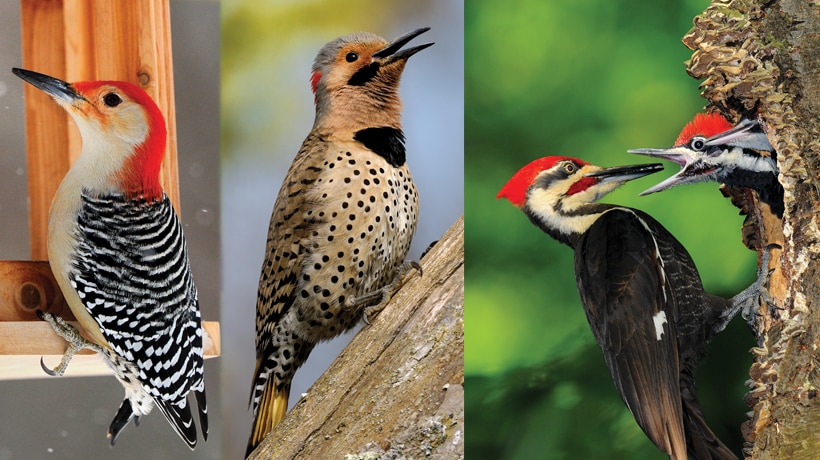Discover the Interesting World of Woodpeckers: Whatever You Required to Know
The globe of woodpeckers is a realm loaded with unique behaviors, complex adaptations, and a varied variety of types. From their habitats and distribution patterns to their feeding behaviors and specialized anatomical attributes, woodpeckers have long astounded the interest of ornithologists and nature lovers alike. Comprehending the complexities of these remarkable birds provides a glance right into the complex interaction between their biology and the atmosphere. As we explore the globe of woodpeckers better, we reveal a wealth of details that clarifies their relevance in communities and the difficulties they face in an ever-changing world.
Woodpecker Habitats and Distribution
Woodpeckers live in a varied series of atmospheres worldwide, showcasing versatility in their circulation patterns. These durable birds are found in forests, forests, savannas, and deserts across various continents, demonstrating their capacity to prosper in different climatic conditions. In The United States and Canada, as an example, woodpeckers can be found in both coniferous and deciduous forests, using their solid beaks to forage for pests and produce nesting dental caries in trees. In Africa, particular woodpecker varieties have adjusted to dry atmospheres, such as the acacia woodlands, where they play an important role in regulating insect populations.
/https://tf-cmsv2-smithsonianmag-media.s3.amazonaws.com/filer_public/30/ac/30acf469-09cd-4fcc-a812-1aa30f477578/aprmay2024_l09_woodpeckers.jpg)
Feeding Behaviors and Diet
Woodpeckers utilize their strong beaks to pierce right into the bark of trees, penetrating for insects and larvae concealed beneath the surface. In addition to bugs, woodpeckers likewise consume nuts, seeds, fruits, and sap.
Woodpeckers are known for their drumming actions, which serves not just to interact with other woodpeckers yet likewise to locate food. The fast drumming sound is developed by the bird pecking on resonant surface areas like dead trees or metal posts. This actions can bring in insects hidden in the timber, permitting the woodpecker to spot their visibility and prey on them.
One-of-a-kind Adjustments for Tree Climbing
In their adept quest of bugs hidden within tree bark, woodpeckers have actually developed impressive physiological functions that equip them with unique adaptations for reliable tree climbing. Woodpeckers have strong neck muscle mass and an one-of-a-kind look at this now head framework that soak up the impact of continuous pecking, permitting them to climb up vertically without triggering harm click to find out more to their minds. These adaptations showcase the unbelievable transformative design that makes it possible for woodpeckers to navigate trees with accuracy and effectiveness.
Diverse Woodpecker Types Worldwide
With over 200 different varieties spread throughout different habitats worldwide, the family of Picidae incorporates an amazing diversity of woodpeckers. These birds can be found in woodlands, forests, savannas, and also metropolitan locations, showcasing their adaptability to various environments. From the famous Northern Flicker in North America to the colorful and elusive Crimson-backed Flameback in Asia, each woodpecker types displays one-of-a-kind attributes in regards to plumage, behavior, and environment preference.
Woodpeckers differ greatly in size, with the diminutive Downy Woodpecker measuring around 6-7 inches in length, while the powerful Lineated Woodpecker can get to up to 17 inches - Woodpeckers in Florida. Their beaks additionally come in different sizes and shapes, showing their feeding practices. Some types focus on removing insects from tree bark, like the Acorn Woodpecker, while others, such as the Black-cheeked Woodpecker, prey on fruits and seeds

Conservation Efforts and Difficulties
Preservation efforts for woodpecker populaces are critical in reducing the effect of environment loss and various other threats facing these diverse bird types. Woodpeckers deal with various obstacles to their survival, mainly due to deforestation, urbanization, climate modification, and invasive species. To address these problems, conservation initiatives concentrate on safeguarding and restoring woodpecker environments, carrying out lasting forestry practices, and raising awareness about the try this importance of these birds in environments.
One significant difficulty in woodpecker preservation is the fragmentation of their environments, causing separated populations that are extra vulnerable to termination - Woodpeckers in Florida. Guardians work to create wild animals hallways and secured areas that attach these fragmented habitats, allowing woodpeckers to relocate in between various areas for feeding, reproducing, and shelter

Final Thought
To conclude, woodpeckers are interesting birds with special adaptations for tree climbing and feeding behaviors. They can be located in varied environments worldwide, encountering preservation obstacles as a result of habitat loss and human tasks. Recognizing their environments, diets, and behaviors is crucial for conservation efforts to secure these important bird species. Further study and preservation actions are required to ensure the survival of woodpeckers in the wild.